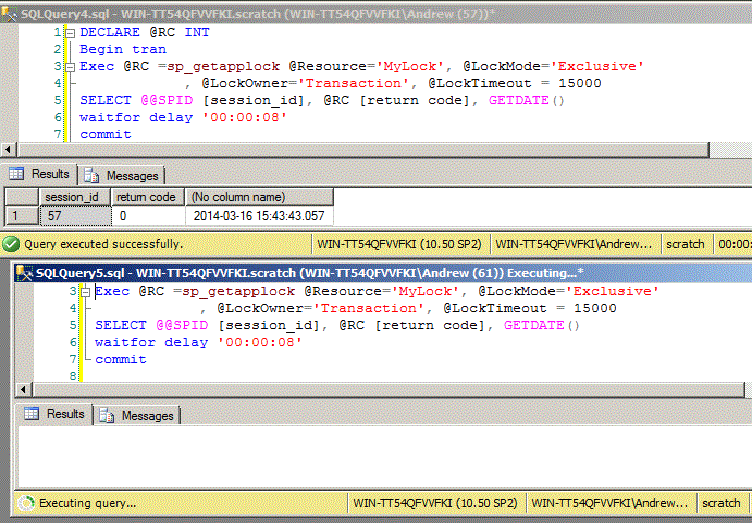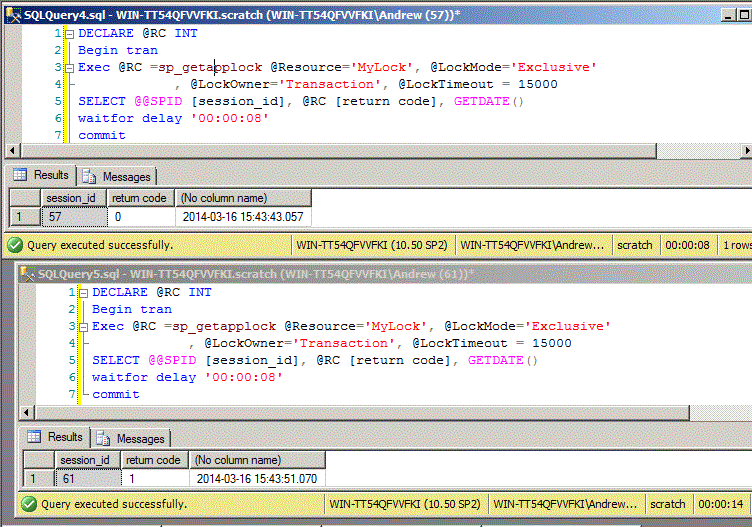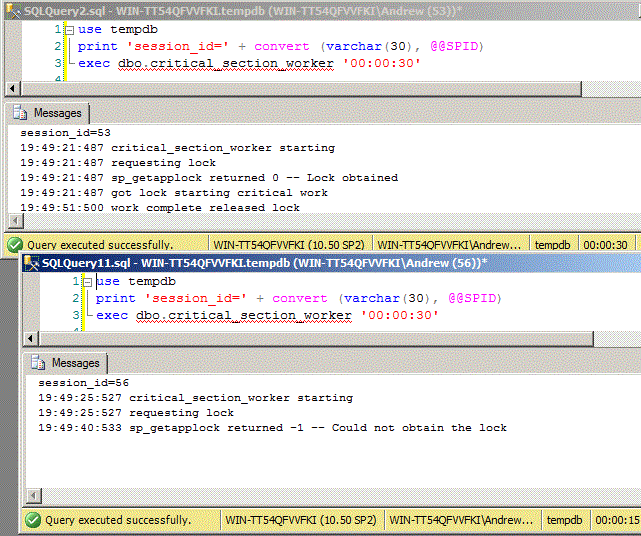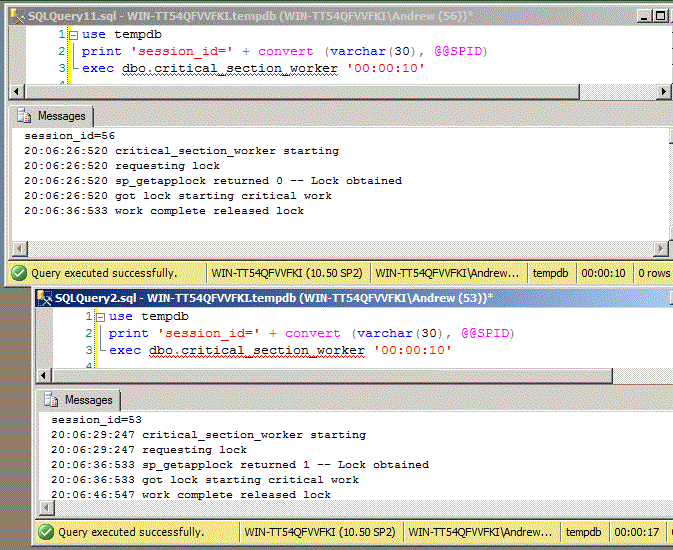By: Andy Novick | Comments (21) | Related: > Locking and Blocking
Problem
There is a stored procedure that must be run by only one user at a time. How do to I prevent multiple users from running the stored procedure at the same time?
Solution
For years I've implemented home grown solutions using a "lock" table but this always had inherent problems with either faulty code or with failures that didn't clean up the lock table. Invariably there were situations where a process died and the "lock" hung around preventing other users from running the protected code. It was always necessary to have a "Clean up the bad locks" feature as part of the application.
A better solution is available: SQL Server provides an application manageable lock mechanism through the sp_getapplock / sp_releaseapplock pair of system stored procedures. They provide a way for application code to use SQL's underlying locking mechanism, without having to lock database rows. The lock can be tied to a transaction or session ensuring lock release when the transaction COMMITs or ROLLSBACK or when the session exits and the connection is closed.
Using sp_getapplock to lock a resource
To obtain a lock, call sp_getapplock as follows:
DECLARE @RC INT
Begin tran
Exec @RC =sp_getapplock @Resource='MyLock', @LockMode='Exclusive'
, @LockOwner='Transaction', @LockTimeout = 15000
SELECT @@SPID [session_id], @RC [return code], GETDATE()
waitfor delay '00:00:08'
commit
The sp_getapplock call takes out a lock to the resource "MyLock" and holds it as long as the transaction is alive. In this case it will wait 8 seconds and then execute the COMMIT, which will release the lock. To see how it works open a Management Studio session and executed the code above, then quickly open another Management Studio window and execute this same code again. That's what I've done in this picture:

The session at the top was started first and immediately returned the resultset with the time as the last column. Then as quickly as I could I started the second session and you can see that it's executing the query. Once it's completed you'll see something like the next picture where both sessions have now completed:

Notice that the return code for the first query is zero, which means that the lock was granted right away. The return code for the second session is one, which means that the lock was granted after waiting for another session that held the lock. There are also negative return codes such as minus one which indicates that the lock could not be granted by the timeout and other negative codes for other error situations. You should also notice the time. Session 2 returned it's result set eight seconds after session 1. That's because it had to wait those eight seconds to acquire the lock.
Once the lock is acquired releasing it depends on the @LockOwner parameter. If @LockOwner is "Session" the lock is held until it is explicitly released with a call to sp_releaseapplock or if the session ends. A session ends when the connection is closed that can be somewhat risky if the caller has a tendency to hold onto connections. If @LockOwner is "Transaction" the lock is released either with a call to sp_releaseapplock or when the transaction is committed or rolled back. Coding tends to be easier when @LockOwner is Transaction so I try and use it whenever possible but, of course, @LockOnwer='Transaction' can only be used inside a user transaction.
Using sp_releasapplock to release a resource
The call to sp_releaseapplock requires the @Resource and @LockOwner parameters and looks like this:
DECLARE @RC INT Exec @RC = sp_releaseapplock @Resource='MyLock', @LockOwner='Transaction' select @RC
However, if @LockOwner='Transaction' then sp_releaseapplock must be executed inside the transaction. In addition, if the lock isn't held by the transaction SQL Server doesn't just return a return code, an explicit error is thrown and the code must account for that possibility. For that reason when using @LockOwner='Transaction' I avoid calling sp_releaseapplock but instead rely on the transaction COMMIT to release the lock.
Stored Procedure Example Using sp_getapplock
Now take a look at how to use sp_getapplock in a stored procedure. The sample procedure, critical_section_worker, includes transaction control, messaging, and error handling typical of a real world procedure that uses sp_getapplock. Here's a script that creates it as a permanent procedure in tempdb.
USE [tempdb]
GO
SET ANSI_NULLS ON
SET QUOTED_IDENTIFIER ON
GO
CREATE PROC dbo.critical_section_worker @wait_duration varchar(30) = '00:01:00' -- default one minute
/* Performs a task in a critical section of code that can only be run
by one session at a time. The task is simulated by a WAIT */
AS
declare @rc int = 0 -- return code
, @msg varchar(2000)
set @msg = convert(varchar,getdate(), 114) + ' critical_section_worker starting'
raiserror (@msg, 0, 1) with nowait
Begin Try
Begin tran
set @msg= convert(varchar,getdate(), 114) + ' requesting lock'
raiserror (@msg, 0, 1) with nowait
Exec @rc = sp_getapplock @Resource='CriticalSectionWorker' -- the resource to be locked
, @LockMode='Exclusive' -- Type of lock
, @LockOwner='Transaction' -- Transaction or Session
, @LockTimeout = 15000 -- timeout in milliseconds, 15 seconds
set @msg= convert(varchar,getdate(), 114) + ' sp_getapplock returned ' + convert(varchar(30), @rc) + ' -- '
+ case when @rc < 0 then 'Could not obtain the lock' else 'Lock obtained' end
raiserror (@msg, 0, 1) with nowait
if @rc >= 0 begin
set @msg= convert(varchar,getdate(), 114) + ' got lock starting critical work '
raiserror (@msg, 0, 1) with nowait
waitfor delay @wait_duration -- Critical Work simulated by waiting
commit tran -- will release the lock
set @msg= convert(varchar,getdate(), 114) + ' work complete released lock'
raiserror (@msg, 0, 1) with nowait
end
else begin
rollback tran
set @rc = 50000
end
end try
begin catch
set @msg = 'ERROR: ' + ERROR_MESSAGE() + ' at '
+ coalesce(ERROR_PROCEDURE(), '')
+ coalesce (' line:' + convert(varchar(30), ERROR_LINE()), '')
RAISERROR (@msg, 0, 1) with nowait -- ensure the message gets out
if @@Trancount > 1 rollback tran
raiserror (@msg, 16, 1)
end catch
return @rc
GO
The lock is held for the duration of the transaction and will be released either by the COMMIT at the end of the TRY block or by the ROLLBACK in the CATCH block. You might notice the use of RAIERROR... WITH NOWAIT instead of PRINT. RAISERROR with a error code of zero isn't really an error and adding the WITH NOWAIT forces the message and any preceding messages to be displayed immediately. I described this feature in detail in the this tip Using the NOWAIT option with the SQL Server RAISERROR statement.
This next picture shows how I ran the query in two windows. The upper window, with session 56, was started first, at 19:15.14.413. The lower window, with session 53, was started 5 seconds later. The upper window grabbed the lock first and held it for 30 seconds. Since the timeout on the call to sp_getapplock is only 15 seconds, the lower session never got the lock and sp_getapplock returned -1.

In this last picture I ran critical_section_worker with a runtime of 10 seconds. This time the lower session got the lock before the timeout and was able to complete it's work but only after waiting for the upper session to complete.

That's exactly what I wanted: only one instance of the stored procedure can enter the critical section, protected by the sp_getapplock call, at a time. It's always better to write code that allows multiple instance to run at the same time, but when that's impossible, or just would take too much effort, I use sp_getapplock to ensure that critical sections are single threaded.
Next Steps
- Locate any places where you've implemented similar functionality using rows in a lock table and replace them with the more robust sp_getapplock.
- Check your code for sections that must be single threaded. These are usually in long running batch routines. If these are not protected from having multiple instances, add the necessary calls to sp_getapplock to add robustness to your code.
About the author
 Andy Novick is a SQL Server Developer in the Boston area with 25 years of database and application development experience.
Andy Novick is a SQL Server Developer in the Boston area with 25 years of database and application development experience.This author pledges the content of this article is based on professional experience and not AI generated.
View all my tips






